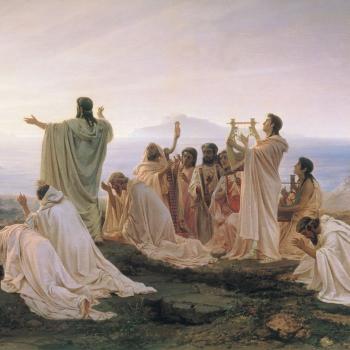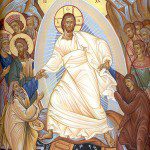
(Wikimedia Commons public domain image)
While going through and trying to organize some materials on my computer, I came across the following file, which was titled “Christ’s Resurrection (UCLA).” Evidently, it is a set of notes for some sort of undated presentation at or near UCLA that I can no longer recall. Their reliance upon an article by the Evangelical philosopher Gary Habermas is unmistakable.
Anyway, I intend soon to clean them up and turn them into connected prose. In the meanwhile, I share them with you in the hope that some might find them of interest:
Denial of Christ’s existence is basically crank territory. (See Bart Ehrman.)
The fact that Jesus was crucified is accepted by virtually everybody. No reputable scholar in the field, believer or nonbeliever, rejects it.[1]
The case for the resurrection of Christ
Multifaceted
Hundreds of relevant articles and books
My argument will rely on data accepted by vast majority on all sides, regardless of prior beliefs.
“it is the virtually unanimous conclusion of contemporary scholars that Jesus’ early followers at least thought that they had seen appearances of the risen Jesus after his death.”[2]
“It is certain noteworthy that the vast majority of scholars, representing many viewpoints, in spite of extensive disagreements in other areas, recognizes that the disciples actually had real experiences of some sort.”[3]
1.
Paul, a former opponent, claimed that the Risen Lord had appeared personally to him. “Have I not seen Jesus our Lord?” he asked the Corinthians.[4] Luke also tells the story three times in the Acts of the Apostles.[5]
There is no serious dispute that Paul, or Saul, shifted, and suddenly, from being an enemy of Christianity to being perhaps its most effective advocate and missionary. “For I am the least of the apostles,” he wrote to the Saints at Corinth, “and do not even deserve to be called an apostle, because I persecuted the church of God.”[6]
“For you have heard of my previous way of life in Judaism,” he reminded the Church in Galatia, “how intensely I persecuted the church of God and tried to destroy it. I was advancing in Judaism beyond many of my own age among my people and was extremely zealous for the traditions of my fathers.”[7]
“If someone else thinks they have reasons to put confidence in the flesh,” he wrote to the believers at Philippi, “I have more: circumcised on the eighth day, of the people of Israel, of the tribe of Benjamin, a Hebrew of Hebrews; in regard to the law, a Pharisee; as for zeal, persecuting the church; as for righteousness based on the law, faultless.”[8]
If we don’t accept his explanation, what alternative is there? Even the atheist philosopher Michael Martin seems to agree that Paul thought that he had seen Christ.[9]
2.
According to Paul, though, he was not the only one who had seen the resurrected Jesus.
“Essentially all critical scholars today agree that in 1 Corinthians 15:3-8, Paul records an ancient oral tradition(s) that summarizes the content of the Christian gospel. Jesus the Christ died for human sin, was buried and raised from the dead, afterwards appearing to both individuals as well as groups of witnesses.”[10]
“For what I received I passed on to you as of first importance: that Christ died for our sins according to the Scriptures, that he was buried, that he was raised on the third day according to the Scriptures, and that he appeared to Cephas, and then to the Twelve. After that, he appeared to more than five hundred of the brothers and sisters at the same time, most of whom are still living, though some have fallen asleep. Then he appeared to James, then to all the apostles, and last of all he appeared to me also, as to one abnormally born.”[11]
“While Paul penned the words, he is clear that this material was not his own but that he had passed on to his listeners years before (1 Cor 15:1-2) what he had received from others, as the very heart of his message (1 Cor 15:3).”[12]
“Now, brothers and sisters, I want to remind you of the gospel I preached to you, which you received and on which you have taken your stand. By this gospel you are saved, if you hold firmly to the word I preached to you. Otherwise, you have believed in vain.”[13]
“what I received I passed on to you as of first importance”[14]
When Paul explains that he had delivered to his audience information that he had first received from others, he seems to be using the terminology that was also used for passing rabbinic tradition on to others.[15]
Moreover, there are textual indications that this is precisely what had occurred. The sentence structure, the diction, the verbal parallelism of the passage, the three-fold sequence of “and that,” as well as the presence of several non-Pauline words, the proper names of Cephas and James, and indications that there may have been an Aramaic original for the passage, all seem strongly to suggest that the tradition was pre-Pauline.[16] And, in fact, critical scholars appear to agree that the Paul had received the material from others.[17]
So Paul’s testimony seems to be years earlier than the book of 1 Corinthians. “It is almost universally agreed today that Paul is here citing tradition.”[18]
The standard scholarly view is that Paul first received this very early material when he visited Jerusalem just three years after his conversion. During this visit, he met with Peter and with James, the brother of Jesus—both of whom had, themselves, see the risen Jesus.[19]
“Then after three years, I went up to Jerusalem to get acquainted with Cephas and stayed with him fifteen days. I saw none of the other apostles—only James, the Lord’s brother.”[20]
One of the Greek words used in the Galatians account, historesai, is very significant, and merits further examination. It “indicates that Paul visited Peter for the purpose of investigating a particular subject.”[21] And the context leaves little question as to what that subject was: Paul wanted to make sure that he had the Christian message right.[22] And Jesus’ resurrection, of course, was for him the very heart of that message.[23] Without it, he was certain, faith was pointless.[24]
Thus, for Ulrich Wilckens, the content of 1 Corinthians 15:3-8 “indubitably goes back to the oldest phase of all in the history of primitive Christianity.”[25] Walter Kasper thinks that this “ancient text” was possibly “in use by the end of 30 A.D.”[26]
Kasper was a Catholic priest and eventually a cardinal, but XXXXXX top of page 184. [Off hand, I don’t quite know what to make of this line, nor what I was thinking when I wrote it.]
Can we move from their thinking so to confidence that they did so?
Religious conversions are commonplace. Does anything distinguish the transformation of the apostles following the claimed resurrection of Jesus?
“The Gospel is centred in God’s Son, a descendant of David by human genealogy and patently marked out as the Son of God by the power of that Spirit of holiness which raised him to life again from the dead.”[27]
The resurrection seems to put a divine seal of approval on the atonement of Christ, which had occurred immediately before.
The Resurrection of Christ proves that there is indeed a God, and certifies the truth of the general Judeo-Christian tradition.
***
“Indeed taking all the evidence together, it is not too much to say that there is no single historic incident better or more variously supported than the Resurrection of Christ. Nothing but the antecedent assumption that it must be false could have suggested the idea of deficiency in the proof of it.”
“He, the Life of all, our Lord and Saviour, did not arrange the manner of his own death lest He should seem to be afraid of some other kind. No. He accepted and bore upon the cross a death inflicted by others, and those other His special enemies, a death which to them was supremely terrible and by no means to be faced; and He did this in order that, by destroying even this death, He might Himself be believed to be the Life, and the power of death be recognised as finally annulled. A marvellous and mighty paradox has thus occurred, for the death which they thought to inflict on Him as dishonour and disgrace has become the glorious monument to death’s defeat.”
― Athanasius of Alexandria, On the Incarnation
“If Jesus rose from the dead, then you have to accept all that he said; if he didn’t rise from the dead, then why worry about any of what he said? The issue on which everything hangs is not whether or not you like his teaching but whether or not he rose from the dead.”
― Timothy Keller, The Reason for God: Belief in an Age of Skepticism
“I know the resurrection is a fact, and Watergate proved it to me. How? Because 12 men testified they had seen Jesus raised from the dead, then they proclaimed that truth for 40 years, never once denying it. Every one was beaten, tortured, stoned and put in prison. They would not have endured that if it weren’t true. Watergate embroiled 12 of the most powerful men in the world-and they couldn’t keep a lie for three weeks. You’re telling me 12 apostles could keep a lie for 40 years? Absolutely impossible.”
― Charles Colson [one of the convicted Watergate conspirators who did prison time and emerged thereafter as a committed Evangelical Christian]
“If the truth is that after there comes a negatively spiritual life, an eternity of mystical experience, what more misleading way of communicating it could possibly be found than the appearance of a human form which eats boiled fish? Again, on such a view, the body would really be a hallucination. And any theory of hallucination breaks down on the fact (and if it is invention, it is the oldest invention that ever entered the mind of man) that on three separate occasions this hallucination was not immediately recognized as Jesus.”
“Even granting that God sent a holy hallucination to teach truths already widely believed without it, and far more easily taught by other methods, and certainly to be completely obscured by this, might we not at least hope that He would get the face of the hallucination right? Is He who made all faces such a bungler that He cannot even work up a recognizable likeness of the Man who was Himself?”
“Perhaps [the critics are right and] the drama is played out now and Jesus is safely dead and buried. Perhaps. It is ironical and entertaining to consider that at least once in the world’s history those words might have been said with complete conviction, and that was on the eve of the Resurrection.”
― Dorothy L. Sayers, The Whimsical Christian: 18 Essays
Christianity, unlike any other religion in the world, begins with catastrophe and defeat. Sunshine religions and psychological inspirations collapse in calamity and wither in adversity. But the Life of the Founder of Christianity, having begun with the Cross, ends with the empty tomb and victory.”
― Fulton J. Sheen, Life of Christ
[1] Habermas, in Beckwith, Craig, and Moreland, To Everyone an Answer, 181.
[2] Habermas, in Beckwith, Craig, and Moreland, To Everyone an Answer, 180-181; E. P. Sanders, The Historical Figure of Jesus *(London: Penguin, 1993), 11, 13.
[3] Habermas, in Beckwith, Craig, and Moreland, To Everyone an Answer, 181-182.
[4] 1 Corinthians 9:1 (NIV). Compare 1 Corinthians 15:8; Galatians 1:15-16.
[5] See Acts 9:1-8, 22:3-11; 26:9-18.
[6] 1 Corinthians 15:9 (NIV).
[7] Galatians1:13-14 (NIV)
[8] Philippians 26:9-18 (NIV).
[9] Michael Martin, The Case Against Christianity *(Philadephia: Temple University Press), 81.
[10] Habermas, in Beckwith, Craig, and Moreland, To Everyone an Answer, 182.
[11] 1 Corinthians 15:3-8 (NIV).
[12] Habermas, in Beckwith, Craig, and Moreland, To Everyone an Answer, 182.
[13] 1 Corinthians 15:1-2 (NIV).
[14] 1 Corinthians 15:3 (NIV).
[15] Habermas, in Beckwith, Craig, and Moreland, To Everyone an Answer, 183. Compare 1 Corinthians 11:23.
[16] For Cephas, compare Luke 24:34.
[17] See the bibliography* at Habermas, in Beckwith, Craig, and Moreland, To Everyone an Answer, 183 note 5.
[18] Reginald Fuller, The Formation of the Resurrection Narratives *(New York: Macmillan, 1980), 10.
[19] See Galatians 1:18-9; 1 Corinthians 15:5, 7.
[20] Galatians 1:18-19 (NIV).
[21] Habermas, in Beckwith, Craig, and Moreland, To Everyone an Answer, 183.
[22] See Galatians 1:11-2:10.
[23] See 1 Corinthians 15:3-4; Galatians 1:11, 16.
[24] 1Corinthians 15:14, 17.
[25] Ulrich Wilckens, Resurrection: Biblical Testimony to the Resurrection: An Historical Examination and Explanation *(Edinburgh: St. Andrew Press, 1977), 2.
[26] Walter Kasper, Jesus the Christ, trans. V. Green (Mahwah NJ: Paulist, 1976), 125.
[27] Romans 1:3-4 (J. B. Phillips).













